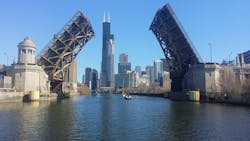Interactive Webpage Makes Chicago Waterway Data Accessible
The Metropolitan Water Reclamation District of Greater Chicago (MWRD) introduced a new mapping tool to help the public understand the health of the Chicago area waterways through data that MWRD collects to monitor the waterways' ecosystems and the rising fish populations. The application covers water quality, fish monitoring, and continuous dissolved oxygen data, and pinpoints these data to a map of sampling stations in Chicago area waterways.
"We are excited to offer this new web-based amenity to keep users informed and prepare them for what they may encounter when recreating, fishing and visiting our waterways," said MWRD President Mariyana Spyropoulos. "We have come a long way in improving our water quality and this meticulous data collection will convey what those records show through a transparent and user-friendly online tool."
MWRD collects monthly water samples at 28 locations throughout the agency's 883-sq-mile service area throughout Cook County. They then return these samples to the lab, where they analyze the water for dozens of chemical and biological constituents. Visitors to the website can review water quality data for ammonia, chloride, fecal coliform, phosphorus and suspended solids. The MWRD also maintains 18 continuous water quality-monitoring stations that collect hourly dissolved oxygen, temperature, and specific conductance measurements in area waterways.
MWRD conducts fish monitoring periodically throughout its service area, which includes the Chicago, Calumet, and Des Plaines River Systems. The number of fish species found in the Chicago Area Waterway System (CAWS) has drastically increased since the 1970s, when monitoring of the fish population first began. From 10 known species in 1974, that number has ballooned to 76 in 2016, including 59 that have been found in the CAWS since 2000. Thanks in part to advancements at MWRD water treatment operations, the waterways have experienced decreases in levels of ammonia and biochemical oxygen demand (BOD). The BOD captures the degree of pollution by measuring the amount of dissolved oxygen (DO) that must be present in water for microorganisms to break down organic matter in the water at a certain temperature over a time period.
"Over the past couple of decades, the world has been profoundly changed by the increased availability of data," said MWRD Commissioner Debra Shore. "We hope that making data about our waterways more accessible and user-friendly will help people understand our water environment better, because it's hard to care about something you don't understand."
These water quality improvements have proven to be essential factors for nurturing aquatic life, while MWRD's Tunnel and Reservoir Plan (TARP) also has helped reduce the amount of combined sewer overflows (CSO), leading to less polluted water and healthier homes for freshwater fish living in the CAWS. In addition to TARP and other measures to improve water quality, the MWRD has introduced sidestream elevated pool aeration stations to help inject needed oxygen into the waterways and implemented chlorination/dechlorination technologies to disinfect water at its Calumet Water Reclamation Plant and UV disinfection at its O'Brien Water Reclamation Plant.
Scientists with the MWRD and the U.S. Department of Energy's (DOE's) Argonne National Laboratory also are currently examining water quality through a groundbreaking seven-year study. The CAWS Microbiome Study examines the complex microbial communities in the CAWS using advanced analytical and computational tools to explore what microorganisms exist, where they came from and what they are doing. The early results indicate that Chicago area waterways have healthy and diverse microbial communities. Like many other river systems, the communities vary in their makeup based on location and a variety of other factors, but are generally stable.
In addition to offering this website to promote transparency and keep the public informed of waterway quality, the MWRD is partnering with other regional agencies and organizations on a campaign to address waterway safety.
Source: Metropolitan Water Reclamation District of Greater Chicago
